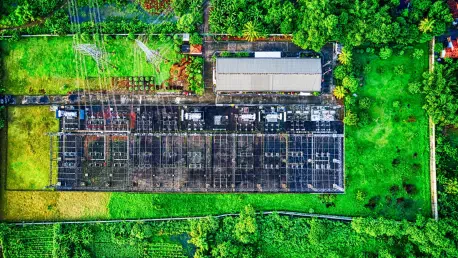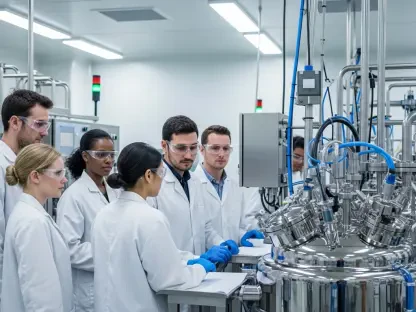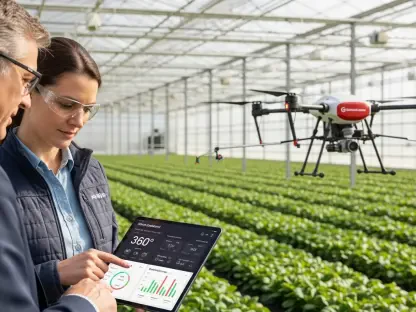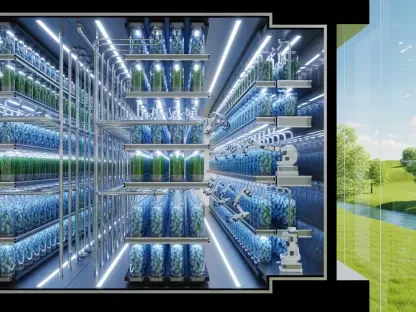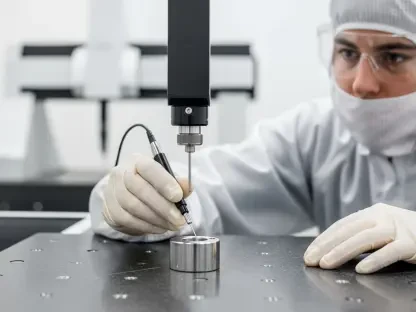In a world increasingly driven by the need for sustainable solutions, the industrial enzymes market stands out as a transformative force within biotechnology and manufacturing sectors, revolutionizing industries from food and beverage to textiles, biofuels, and detergents. These biological catalysts enhance process efficiency, slash energy consumption, and promote environmentally conscious practices. A recent comprehensive report projects this vibrant market to soar from USD 7.9 billion currently to a staggering USD 14.4 billion by 2035, fueled by a consistent compound annual growth rate (CAGR) of 6.2%. This remarkable 82.3% growth over the next decade signals not just a trend, but a fundamental shift in how industries operate. The surge is underpinned by a global push for greener manufacturing, consumer demand for natural products, and rapid advancements in enzyme technology. As industries worldwide grapple with balancing efficiency and environmental responsibility, industrial enzymes are emerging as a cornerstone of modern progress, promising both innovation and opportunity.
Market Growth Drivers and Trends
Sustainability and Circular Economy Push
The relentless drive toward sustainability is reshaping industrial practices, with enzymes playing a pivotal role as a cleaner alternative to traditional chemical processes. Across the globe, manufacturers are under mounting pressure to comply with stringent environmental regulations and reduce their ecological footprint. Industrial enzymes offer a compelling solution by minimizing waste, lowering energy use, and enabling processes that align with green mandates. This shift is particularly evident in sectors like textiles and detergents, where enzyme-based methods are replacing harsher chemicals. The adoption of these biological catalysts not only helps companies meet regulatory standards but also enhances their reputation as environmentally responsible entities. As industries pivot to more sustainable models, the role of enzymes in reducing resource depletion and pollution becomes increasingly critical, positioning them as indispensable tools in the quest for a greener future.
Another dimension of this sustainability focus is the integration of enzymes into the circular economy framework, where the emphasis lies on maximizing resource efficiency. By facilitating processes that recycle materials and reduce byproducts, enzymes help industries close the loop on waste. For instance, in biofuel production, enzymes break down organic matter into usable energy sources, supporting renewable energy goals. This approach resonates with global initiatives to rethink manufacturing from a linear “take-make-dispose” model to one that prioritizes reuse and regeneration. Governments and corporations alike are championing these principles, often incentivizing enzyme adoption through policies and funding. The result is a market dynamic where sustainability isn’t just a buzzword but a tangible driver of growth, pushing companies to innovate while addressing pressing environmental challenges with practical, enzyme-driven solutions.
Consumer Demand for Natural Products
A significant force propelling the industrial enzymes market forward is the rising consumer preference for natural and clean-label products, particularly in the food and beverage industry. Today’s consumers are more informed and discerning, seeking transparency about ingredients and production methods. They demand products free from artificial additives, prompting manufacturers to turn to enzymes as a natural means of ensuring quality and safety. In baking, for example, enzymes improve dough consistency without synthetic enhancers, while in dairy, they aid in creating lactose-free options for health-conscious buyers. This trend reflects a broader shift toward wellness and authenticity, compelling companies to adapt their processes to meet market expectations. Enzymes, with their ability to deliver on these fronts, are becoming a vital component in maintaining consumer trust and competitive edge.
Beyond mere preference, this consumer-driven movement is reshaping regulatory landscapes and industry standards, further accelerating enzyme adoption. Food safety and labeling requirements are tightening globally, pushing manufacturers to seek solutions that comply with these evolving norms. Enzymes not only help meet such standards but also enhance product shelf life and consistency, reducing the need for preservatives. This dual benefit is especially critical in a market where brand loyalty hinges on perceived integrity. As health and environmental awareness continue to grow among consumers, the reliance on enzyme technology to craft natural, high-quality goods is expected to intensify. This dynamic underscores a profound alignment between market demand and technological capability, positioning enzymes at the heart of a consumer-centric industrial evolution.
Market Segmentation Insights
Product Leadership with Proteases
Among the diverse array of industrial enzymes, proteases stand out as market leaders, commanding a substantial 28.8% share of the current market. Their dominance stems from unparalleled versatility in breaking down proteins, making them indispensable across multiple sectors. In food processing, proteases are crucial for applications like cheese production and meat tenderizing, enhancing both texture and flavor. In detergents, they excel at stain removal by degrading protein-based residues, while in textiles, they assist in fabric treatment for smoother finishes. This wide-ranging utility ensures that proteases remain a cornerstone of enzyme applications, directly impacting product quality and operational efficiency. Their ability to streamline complex processes while delivering consistent results cements their position as a preferred choice for manufacturers aiming to optimize output without compromising on standards.
The significance of proteases extends beyond their current market share to their potential for future innovation. As industries continue to seek cost-effective and sustainable solutions, the demand for specialized proteases tailored to specific needs is on the rise. Biotechnology advancements are enabling the development of enzymes with enhanced stability under extreme conditions, such as high temperatures or acidic environments, broadening their applicability. This adaptability is particularly valuable in sectors facing unique challenges, like pharmaceutical manufacturing, where precision is paramount. The ongoing research into protease variants promises to unlock new industrial possibilities, ensuring that this enzyme category retains its leadership. With such a robust foundation, proteases are set to play an even larger role as the market evolves over the coming decade.
Dominance of Microbial Sources
When it comes to the sources of industrial enzymes, microorganisms reign supreme, accounting for an impressive 75.4% of market demand. This dominance is largely due to the scalability and cost-effectiveness of microbial enzyme production, which allows for consistent, high-volume output. Derived through fermentation processes, these enzymes are sourced from bacteria and fungi, offering reliability that meets the rigorous demands of industrial applications. The ability to cultivate microorganisms under controlled conditions ensures a steady supply, making them a practical choice for manufacturers across sectors like food processing and biofuels. Moreover, their adaptability to genetic modification enables the creation of enzymes with specific traits, addressing niche industrial requirements with precision and efficiency.
The edge of microbial sources is further sharpened by continuous advancements in fermentation technology and genetic engineering. These innovations have significantly improved the quality and yield of enzymes, reducing production costs while enhancing performance. For instance, genetically engineered microbes can produce enzymes with greater thermal stability, vital for harsh industrial environments. This technological progress not only sustains the market’s reliance on microbial sources but also expands their potential applications, from detergents to animal feed. As sustainability becomes a priority, the eco-friendly nature of microbial production—requiring fewer resources compared to plant or animal sources—adds another layer of appeal. This confluence of practicality and innovation ensures that microorganisms will remain the backbone of enzyme supply for the foreseeable future.
Food and Beverage as Top Application
The food and beverage sector leads the industrial enzymes market with a commanding 22.2% share, driven by an unyielding focus on safety, quality, and regulatory compliance. Enzymes are integral to processes like brewing, baking, and dairy production, where they enhance flavor, texture, and shelf life without artificial additives. This aligns perfectly with the clean-label movement, as consumers increasingly demand natural and transparent products. For instance, enzymes facilitate lactose breakdown in milk products, catering to dietary needs, while in baking, they improve dough handling for better consistency. Their role in ensuring food safety by reducing contaminants further solidifies their importance, making them a trusted tool for manufacturers navigating stringent global standards.
Beyond functionality, the adoption of enzymes in food and beverage reflects a deeper alignment with consumer health trends and market dynamics. As awareness of nutrition and wellness grows, producers are under pressure to deliver goods that meet both taste and health criteria. Enzymes offer a natural solution, enabling the reduction of sugars or fats in formulations without sacrificing quality. This adaptability is crucial in a competitive landscape where differentiation is key. Additionally, the sector’s growth is fueled by rising global populations and urbanization, which amplify demand for processed, high-quality foods. With enzymes at the forefront of addressing these needs, their significance in shaping the future of food production is undeniable, promising sustained market leadership as consumer expectations continue to evolve.
Regional Growth Patterns
Asia Pacific’s Rapid Rise
Asia Pacific is emerging as the powerhouse of the industrial enzymes market, characterized by rapid growth and dynamic industrial expansion. Leading the charge is China, with a projected CAGR of 8.4%, driven by swift industrialization, robust biotechnology advancements, and supportive environmental policies. India follows closely with a 7.8% CAGR, bolstered by its thriving pharmaceutical, textile, and food processing sectors, alongside government initiatives promoting biotech innovation. The region benefits from significant cost advantages and an expanding production capacity, making it a magnet for both domestic and international manufacturers. This growth trajectory reflects a broader trend of industrial modernization, positioning Asia Pacific as a critical hub for enzyme adoption and market expansion over the next decade.
The region’s rise is further fueled by a combination of demographic and economic factors that create a fertile ground for enzyme applications. A large and growing population drives demand for processed foods, textiles, and sustainable energy solutions, all of which rely heavily on enzymes. Additionally, increasing foreign investment in biotechnology infrastructure is enhancing local capabilities, enabling countries in the region to compete on a global scale. Environmental challenges, such as pollution and resource scarcity, are also prompting stricter regulations, which in turn accelerate the shift toward enzyme-based, eco-friendly processes. As Asia Pacific continues to balance rapid development with sustainability goals, the industrial enzymes market stands to gain immensely, solidifying the region’s role as a growth engine for the industry.
Innovation and Stability in Europe and North America
Europe distinguishes itself in the industrial enzymes market through a strong emphasis on research and development, underpinned by advanced manufacturing infrastructure. Germany leads with a projected CAGR of 7.1%, leveraging its technological expertise to pioneer enzyme innovations across various industries. France, with a 6.5% CAGR, focuses on food processing advancements and strategic biotech partnerships, while the UK, at 5.9% CAGR, prioritizes operational efficiency through enzyme integration. The region’s commitment to sustainability is a significant driver, with policies encouraging greener industrial practices spurring enzyme adoption. This blend of innovation and regulatory support ensures that Europe remains a key player, consistently pushing the boundaries of what enzymes can achieve in modern manufacturing.
Across the Atlantic, North America maintains its leadership in the industrial enzymes market, anchored by the United States with a projected CAGR of 5.3%. This growth is driven by a cutting-edge biotechnology ecosystem, substantial investments in research, and a regulatory framework that fosters innovation. The region excels in developing advanced enzyme applications for diverse sectors, from food production to biofuels, supported by state-of-the-art manufacturing capabilities. North America’s focus on integrating technology with industrial needs ensures a steady stream of breakthroughs, maintaining its competitive edge globally. As both Europe and North America continue to prioritize sustainability alongside technological progress, their stable growth and innovative contributions are set to shape the future landscape of the industrial enzymes market, balancing tradition with forward-thinking solutions.
